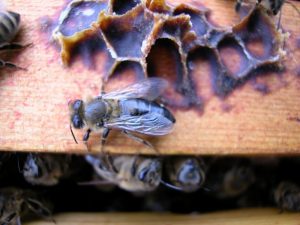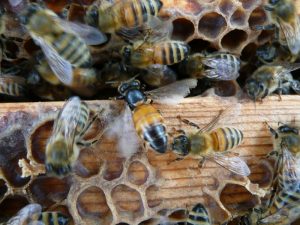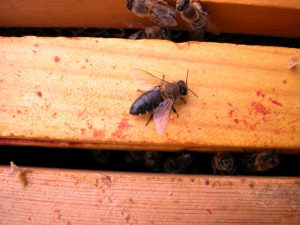
Chronic Bee Paralysis Virus (CBPV)-infected bees are characteristically ‘shiny and black’. These bees in infected hives are often found isolated, motionless and/or shaking on the top bars. When the colony is smoked they do not tend to move down between the frames as the other ‘normal’ bees do. Abdomens may also be distended and the wings dislocated. They can’t fly and so can also be seen crawling in front of the hives.

Symptoms and Cause
CBPV was identified as a cause of adult bee paralysis after long suspicion that the tracheal mite, Acarapis woodi, was the culprit of the paralysis. CBPV was extracted from naturally paralyzed bees as one of the first viruses isolated from honey bees and has since been detected in adult bees of A. mellifera from almost every continent.
CBPV mainly attacks adult bees and causes two forms of ‘paralysis’ symptoms in bees. The most common one is characterized by an abnormal trembling of the body and wings, crawling on the ground due to the flight inability, bloated abdomens, and dislocated wings. The other form is identified by the presence of hairless, shiny, and black-appearing bees that are attacked and rejected from returning to the colonies at the entrance of the hives by guard bees. Both forms of symptoms can be seen in bees from the same colony. The variation in the disease symptoms may reflect differences among individual bees in inherited susceptibility to the multiplication of the virus.
The close contact of overcrowded bees breaks hairs from the cuticle, allowing CBPV to spread from diseased bees to healthy bees via their exposed epidermal cytoplasm. It is likely that any factors that result in decreased foraging activities and crowded conditions in the bee colonies may lead to disease outbreaks of CBPV. It has been reported that CBPV is very widespread in Britain and infects most bees and can cause mortality in bee colonies particularly during long periods of confinement.

Adapted from BeeBase, National Bee Unit, Animal Health and Plant Agency (APHA) under the terms of the Open Government Licence (OGL). Crown Copyright.